There’s nothing quite as frustrating as eagerly anticipating a perfectly cooked bowl of rice, only to find your rice cooker bubbling over and making a mess. Don’t worry – you’re not alone. Many people struggle with this issue, but there are steps you can take to prevent it from happening. In this article, we’ll explore the reasons why your rice cooker may be bubbling over and provide tips on how to properly measure rice and water ratios, adjust cooking temperatures, and remove starch buildup. We’ll also discuss alternative cooking methods and provide suggestions for enhancing your rice cooking experience.
Key Takeaways:
- Overfilling the rice cooker can cause bubbling over. Properly measure rice and water ratios to avoid this issue.
- Using incorrect water levels in the rice cooker can also cause bubbling over. Make sure to follow the manufacturer’s instructions.
- Starch buildup in the rice cooker can contribute to bubbling over. Regular cleaning and maintenance can prevent this from happening.
- The cooking temperature of the rice cooker can affect the likelihood of bubbling over. Adjust it according to the rice type being cooked.
- Rinsing and soaking rice before cooking can help prevent bubbling over.
- If all else fails, alternative cooking methods such as stovetop cooking or using a pressure cooker can be used.
Understanding the Problem
If your rice cooker is bubbling over during the cooking process, there are several potential reasons why. Understanding the problem is the first step in addressing it and preventing it from happening in the future.
Overfilling the rice cooker is one common cause of bubbling over. If you add too much rice or water to the cooker, it will not have enough space to expand and may boil over. It’s important to measure the proper ratios of rice and water according to the rice cooker’s instructions.
Another issue that can lead to bubbling over is incorrect water levels. If you add too much or too little water, it can impact the cooking process and cause the rice to boil over. Refer to the rice cooker’s instructions or consult a troubleshooting guide if you are unsure of the appropriate water level for the type of rice you are cooking.
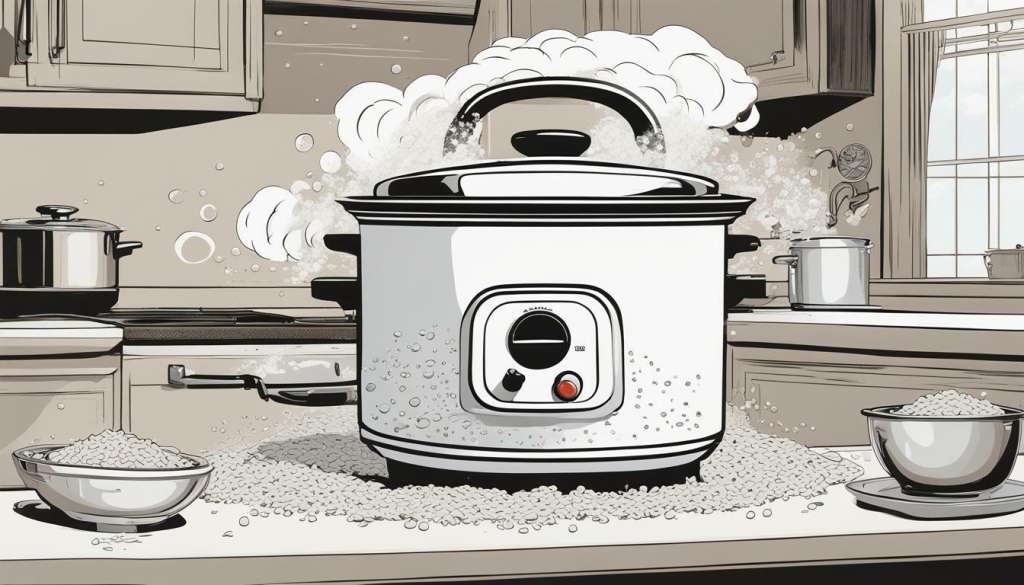
Overfilling the Rice Cooker
If you’re experiencing bubbling over in your rice cooker, one possible culprit may be overfilling. It’s important to properly measure the rice and water for each batch to avoid this issue.
First, start by checking your rice cooker’s capacity. Most models have markings on the inside indicating how much rice and water to add. If there are no markings, use the following general guideline:
| Rice Type | Cups of Rice | Cups of Water |
|---|---|---|
| White Rice | 1 | 1.5 |
| Brown Rice | 1 | 2.5 |
| Wild Rice | 1 | 3 |
It’s important to remember that rice will expand as it cooks, so leaving extra space in the cooker is crucial to prevent bubbling over. As a general rule, aim to fill the cooker no more than halfway with rice and water.
If you’re still experiencing bubbling over despite following these guidelines, it may be worth investing in a larger rice cooker or cooking in batches to avoid overfilling. Remember, proper measuring and filling will not only prevent bubbling over, but it will also result in perfectly cooked rice every time.
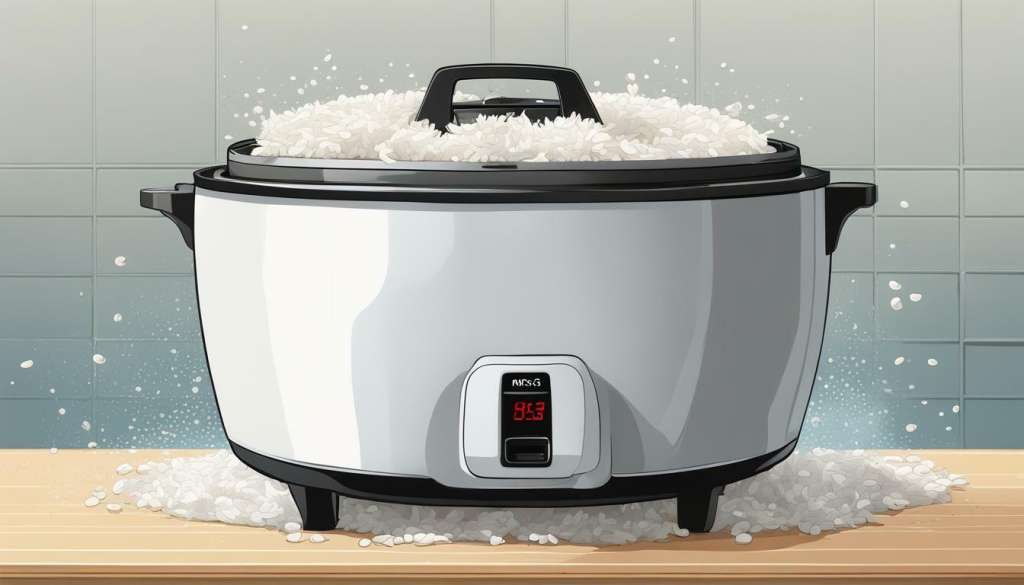
Incorrect Water Level
Using the correct amount of water is crucial to preventing bubbling over in your rice cooker. If there is not enough water, the rice will not cook properly and may stick to the bottom of the cooker, causing bubbling over. On the other hand, if there is too much water, the rice cooker may become overfilled and spill over.
To ensure the correct water level, always read the instructions for your specific rice cooker model and rice type. As a general rule, the ratio of rice to water is usually 1:1.5 or 1:2, with more water needed for softer rice. However, some rice cookers may require different ratios or have markings on the inner pot to indicate water levels for specific rice types.
If you are experiencing bubbling over and suspect the water level may be the issue, try adjusting the amount of water used and monitor the rice cooker closely during the cooking process. If the problem persists, consult the troubleshooting section in the user manual or contact the manufacturer for further assistance.
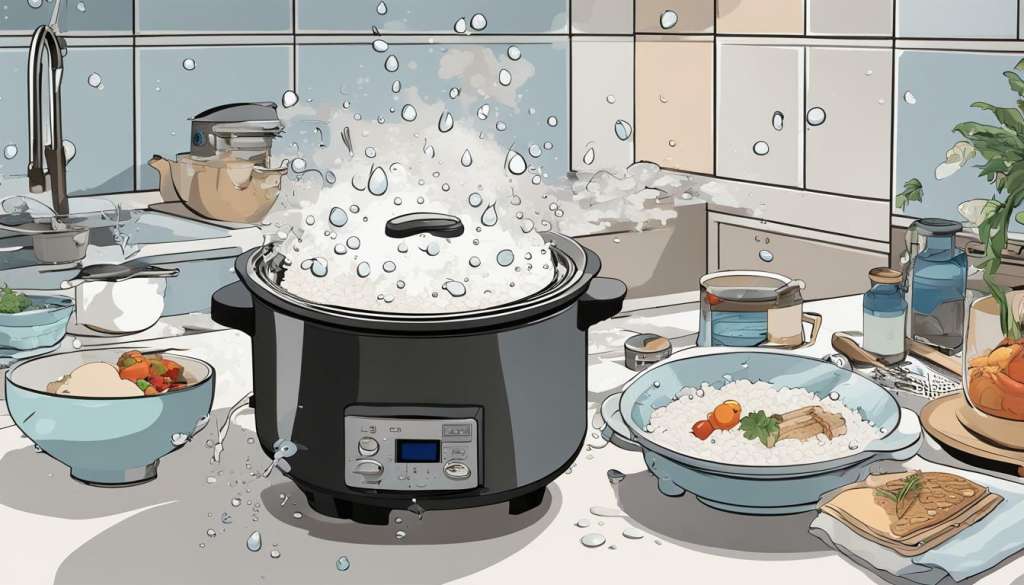
Starch Buildup in Rice Cookers
Rice cookers can be a time-saving and convenient kitchen appliance, but they require regular maintenance to function effectively. A common issue that can arise is the buildup of starch in the cooker.
Starch buildup occurs when rice particles become stuck to the bottom and sides of the cooker during the cooking process. As more rice is cooked without proper cleaning, the starch accumulates and can contribute to bubbling over.
To prevent starch buildup, it’s important to clean the rice cooker thoroughly after each use. After the rice has been removed, allow the cooker to cool down before cleaning it. Use a soft sponge or cloth to wipe the cooker’s interior, paying special attention to the bottom and sides. For stubborn stains, use a mixture of water and vinegar to scrub the interior of the cooker.
Another way to prevent starch buildup is to add a small amount of vegetable oil to the cooking process. The oil will coat the rice and prevent it from sticking to the sides and bottom of the cooker.
If starch buildup has already occurred, it can be removed by soaking the cooker in a solution of warm water and vinegar for several hours. Afterward, the rice cooker can be scrubbed with a soft sponge or cloth to remove any remaining buildup.
Regular maintenance of your rice cooker, including cleaning and proper usage, can help prevent bubbling over and ensure a smooth and delicious rice cooking experience.
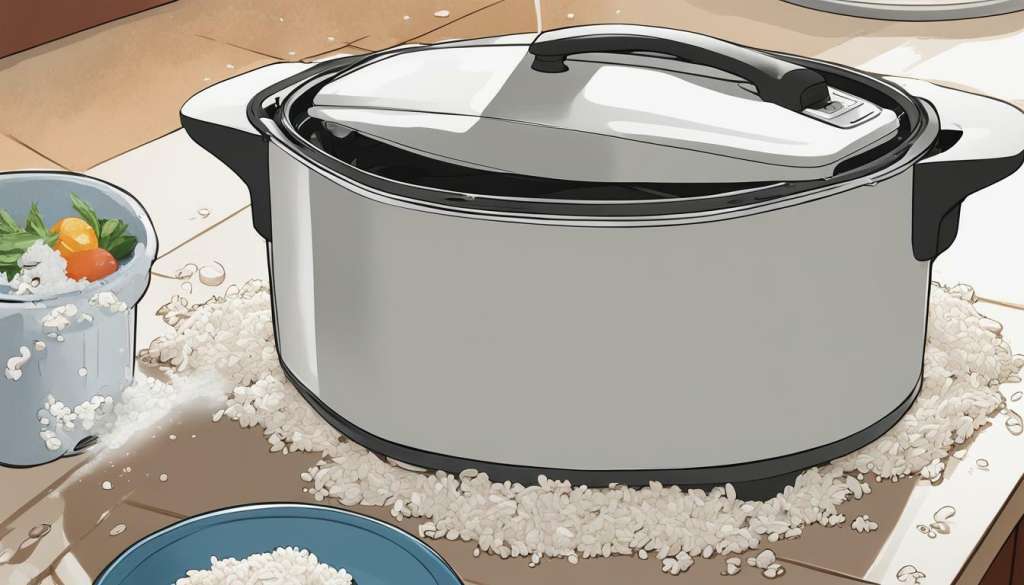
Cooking Temperature
The cooking temperature of your rice cooker is another factor that can affect its performance and the likelihood of bubbling over. Different types of rice may require different cooking temperatures, so it’s important to adjust the temperature setting accordingly.
If you are experiencing bubbling over, try lowering the temperature setting. However, be careful not to lower it too much, as this can result in undercooked or unevenly cooked rice.
It’s also important to note that older rice cookers may have difficulty maintaining a consistent temperature, which can lead to bubbling over and other cooking issues. If your rice cooker is more than a few years old, it may be time to consider replacing it with a newer model.
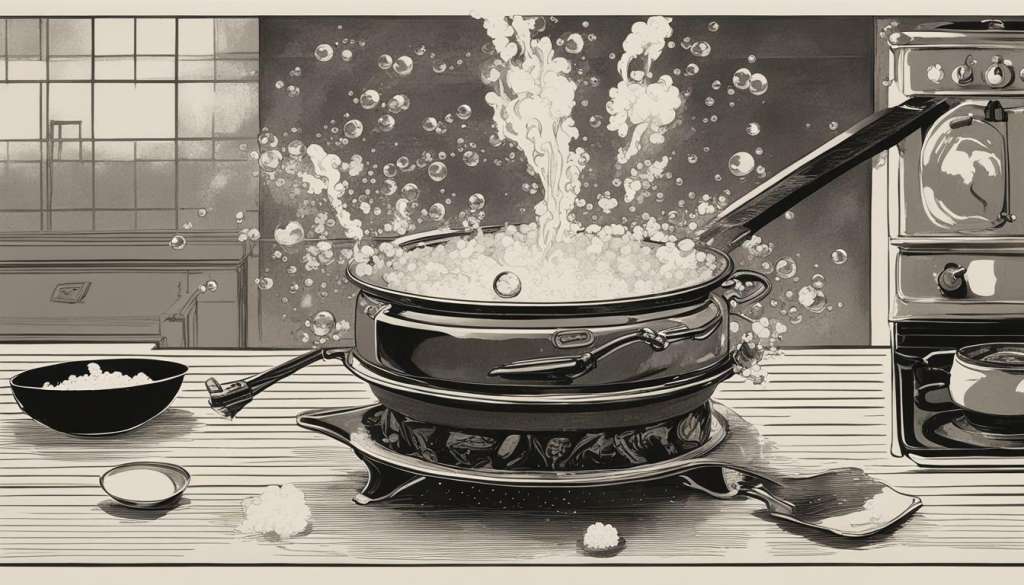
When purchasing a new rice cooker, look for one with accurate temperature controls and consistent heating elements to ensure the best cooking results.
Preparing Rice for Cooking
Properly preparing rice before cooking can help prevent bubbling over in your rice cooker. Rinsing your rice before cooking removes excess starch that can cause the rice to boil over. Soaking the rice for 20 minutes before cooking can also help ensure evenly cooked rice.
When measuring rice and water for your rice cooker, it’s important to follow the recommended ratios for your specific rice type. Using too much water can cause bubbling over. A general rule of thumb is to use 1.5 cups of water for every cup of white rice and 2 cups of water for every cup of brown rice.
Adding a small amount of oil or butter to the rice and water mixture can also help prevent bubbling over. This helps create a barrier on top of the water, preventing it from boiling over. However, be careful not to add too much oil or butter, as it can affect the taste and texture of the cooked rice.
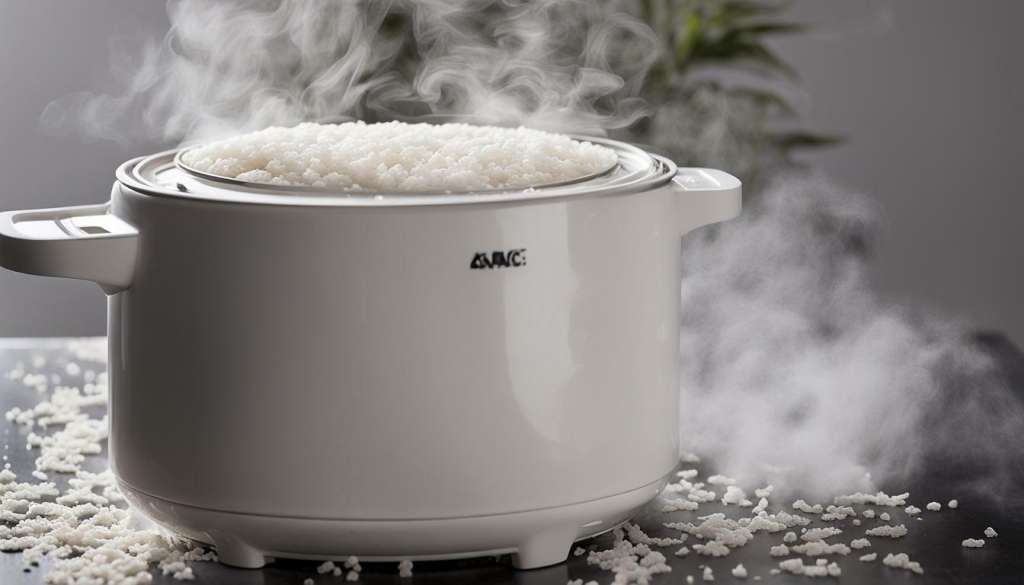
Lastly, consider adding seasonings or other ingredients to your rice cooker to enhance the flavor of your rice. Experiment with different recipes and kitchen tools, such as a rice paddle or steamer basket, to create unique and delicious rice dishes.
Maintenance and Troubleshooting Tips
While proper rice cooker usage can prevent bubbling over, it’s important to also maintain and troubleshoot your rice cooker on a regular basis to ensure it functions correctly. Here are a few tips to help:
Rice Cooker Maintenance
To prevent bubbling over, make sure to clean your rice cooker regularly. After each use, wipe down the heating plate and inner pot with a damp cloth. Remove any excess starch or debris that may have accumulated. Be sure to also check the vent for any blockages that could cause the pressure to build up and lead to bubbling over.
Additionally, consider descaling your rice cooker every few months to remove any mineral buildup that may have accumulated over time. Simply mix equal parts water and white vinegar and pour the mixture into the inner pot. Let it sit for a few hours, then rinse thoroughly with water and dry.
Troubleshooting Rice Cooker Issues
If you’re experiencing issues with your rice cooker, here are some common problems and their solutions:
| Problem | Solution |
|---|---|
| Rice is undercooked or overcooked | Check that you’re using the correct rice to water ratio for your rice cooker and type of rice. If your rice is still undercooked, add more water and continue cooking. If it’s overcooked, use less water next time and reduce the cooking time. |
| Rice cooker won’t start | Make sure the power cord is properly plugged in and that the rice cooker is securely closed. Check that the inner pot is placed in the correct position and that the lid is properly sealed. |
| Rice cooker is bubbling over | Refer to the previous sections for tips on preventing bubbling over. Check that the water level isn’t too high and make sure the inner pot is securely placed in the rice cooker. If the issue persists, try reducing the cooking temperature or using a different rice type. |
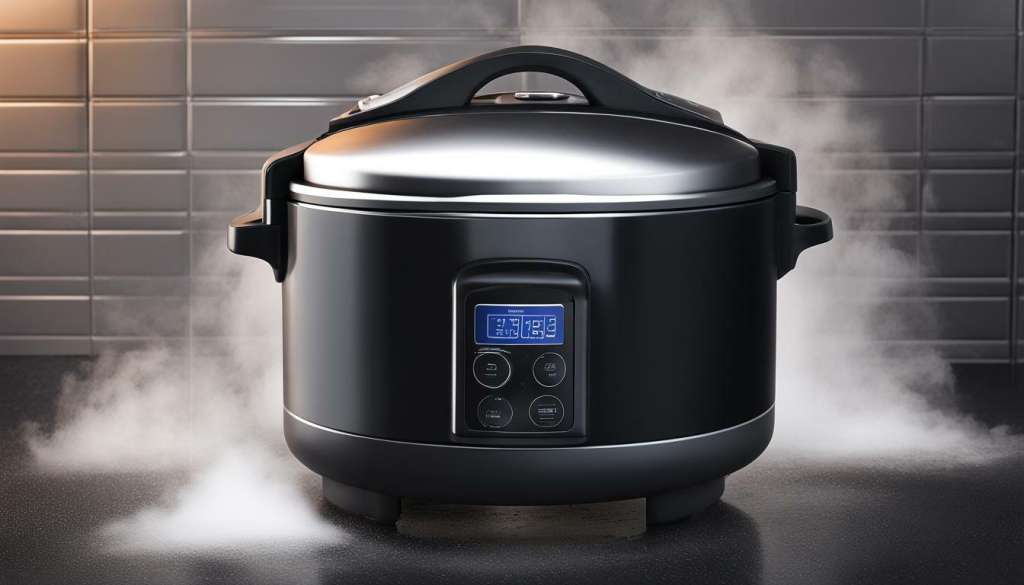
By properly maintaining and troubleshooting your rice cooker, you can prevent bubbling over and ensure your rice comes out perfectly cooked every time.
Alternative Cooking Methods
If bubbling over continues to be a problem with your rice cooker despite following the tips provided in the previous sections, there are alternative cooking methods you can try. These methods may require different kitchen tools and cookware, but they can still produce delicious and perfectly cooked rice.
Stovetop Method
The stovetop method is a traditional and simple way to cook rice. Simply add your rinsed rice and the appropriate amount of water to a pot and bring it to a boil. Once boiling, reduce the heat to low and let it simmer until all the water is absorbed and the rice is cooked to your desired texture. This method may require more attention than a rice cooker, but it still produces great results.
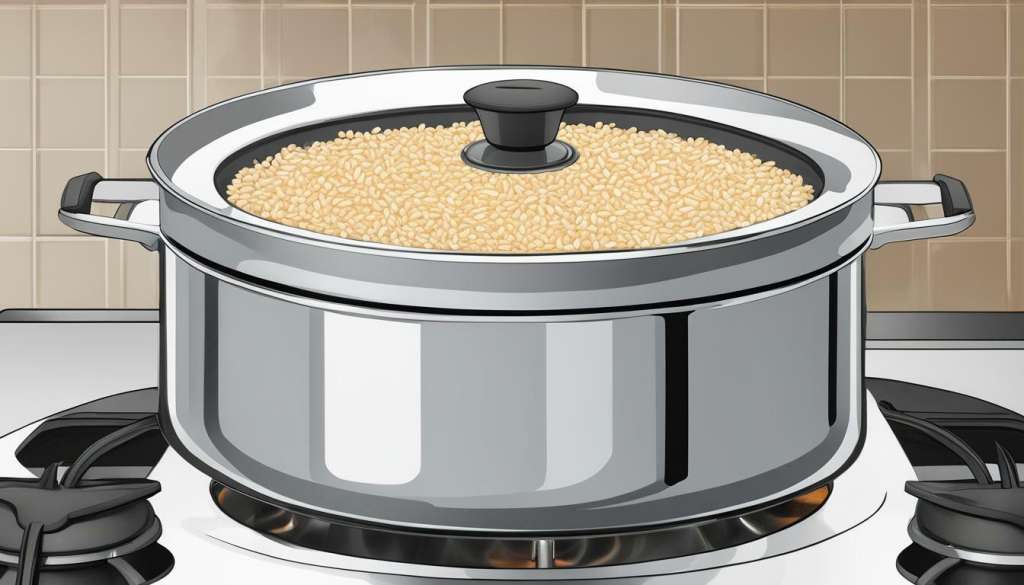
Microwave Method
The microwave method is perfect for those who want a quick and easy way to cook rice. Add your rinsed rice and the appropriate amount of water to a microwave-safe dish, cover it, and microwave on high for 10-15 minutes. Let it rest for a few minutes before serving. This method may require some trial and error to find the right cooking time for your microwave, but it is a convenient option.
Instant Pot Method
The Instant Pot is a versatile kitchen tool that can also cook rice. Simply add your rinsed rice and the appropriate amount of water to the Instant Pot, set it to the rice setting, and let it do the work for you. This method is great for those who want to multitask while cooking or who need to cook large quantities of rice.
Remember, no matter which cooking method you choose, always measure your rice and water carefully, rinse and soak your rice beforehand, and adjust cooking times and temperatures depending on the type of rice you are cooking.
Enhancing Rice Cooking Experience
Mastering the art of rice cooking can be a delicious and rewarding experience. Here are some additional tips and tools to enhance your rice cooking skills:
Try New Rice Recipes
Experiment with different rice varieties and recipes to discover new and exciting flavors. From classic dishes like fried rice and risotto to exotic options like coconut rice and sushi rolls, the possibilities are endless. Check out online recipe websites or cookbooks for inspiration.
Invest in Quality Kitchen Tools
Investing in quality kitchen tools can make all the difference in your rice cooking experience. Consider purchasing a rice cooker with advanced features like fuzzy logic technology or an induction heating system for precise temperature control. A good quality strainer, measuring cups, and a rice paddle can also help you achieve perfect rice every time.
Use High-Quality Ingredients
To get the best results from your rice cooking, start with high-quality ingredients. Look for premium rice brands like Jasmine or Basmati, which offer superior flavor and texture. You can also add extra flavor to your rice by incorporating fresh herbs, spices, or broth.
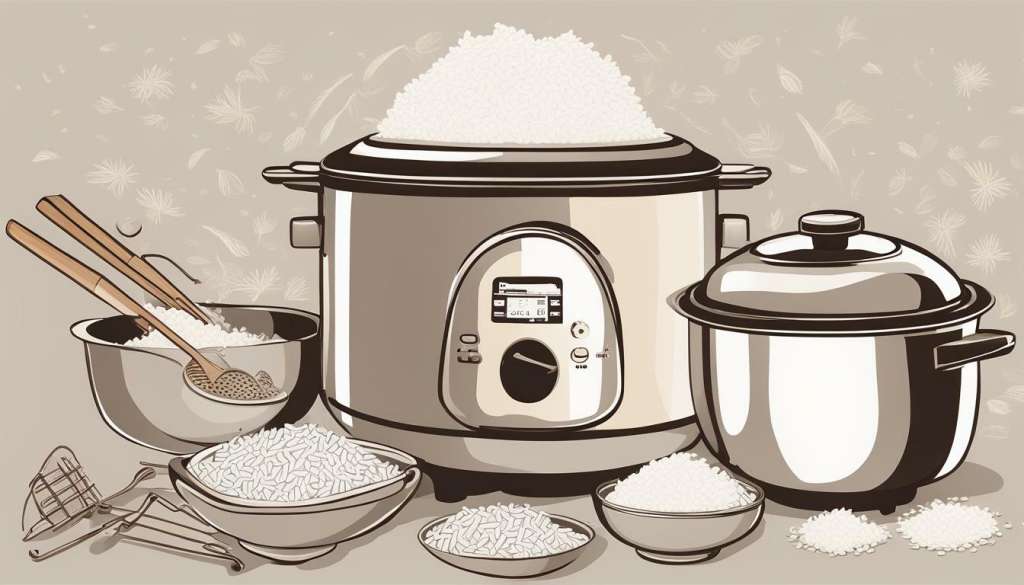
Experiment with Rice Alternatives
If you’re looking to mix up your rice cooking routine, try experimenting with alternatives like quinoa, couscous, or farro. These grains offer unique flavors and textures and can be prepared similarly to rice. You can also mix different grains together to create your own custom blend.
Don’t Forget the Condiments
Condiments like soy sauce, teriyaki sauce, and hot sauce can add a burst of flavor to your rice. Experiment with different sauces and seasonings to find your perfect combination.
Preparation is Key
Preparation is key to successful rice cooking. Rinse your rice thoroughly before cooking to remove excess starch and debris. Soak the rice for at least 30 minutes to 1 hour to ensure even cooking. Proper preparation will result in fluffy and delicious rice.
With these tips and tricks, you’ll be well on your way to becoming a rice cooking master.
Conclusion
Proper usage of a rice cooker is essential to avoid bubbling over. By understanding the common issues that can cause this problem and following the tips provided in this article, you can ensure that your rice is cooked perfectly every time without any mess.
Remember to measure your rice and water ratios accurately, use the correct water levels, and clean your rice cooker regularly to prevent starch buildup. Additionally, rinsing and soaking your rice before cooking can also help to avoid bubbling over.
If despite following these tips, your rice cooker still bubbles over, consider alternative cooking methods such as stovetop cooking or a pressure cooker. And don’t forget to explore different rice recipes and try out new kitchen tools to enhance your rice cooking experience. Is it normal for rice cooker to bubble over occasionally? Sometimes, no matter how careful we are, appliances can act up. If you find that your rice cooker is consistently bubbling over, it may be a sign that it needs to be replaced or repaired. Don’t be afraid to reach out to the manufacturer for guidance or consider investing in a newer model.
Conclusion:
Use your rice cooker as a valuable kitchen appliance, but make sure to follow these tips to avoid the common issue of bubbling over. By doing so, you can enjoy perfect rice every time without any mess.
FAQ
Q: Why is my rice cooker bubbling over?
A: Bubbling over in a rice cooker can be caused by several factors, including overfilling the cooker, using an incorrect water level, starch buildup, cooking temperature, and improper rice preparation.
Q: How can I prevent my rice cooker from bubbling over?
A: To prevent bubbling over, make sure to properly measure the rice and water ratios, avoid overfilling the cooker, use the correct water level, clean the rice cooker regularly to remove starch buildup, adjust the cooking temperature for different rice types, and rinse and soak the rice before cooking.
Q: What should I do if my rice cooker continues to bubble over despite following the tips?
A: If your rice cooker continues to bubble over, you can try alternative cooking methods for rice, such as using a stovetop or microwave, or consider using different kitchen tools or cookware specifically designed for rice cooking.
Q: Are there any additional tips to enhance the rice cooking experience?
A: Absolutely! To enhance your rice cooking experience, you can try different rice recipes, experiment with flavors and seasonings, and invest in kitchen tools like a rice paddle or steamer basket to achieve perfect results.
Q: Why is proper rice cooker usage important to avoid bubbling over?
A: Proper rice cooker usage is important to avoid bubbling over because it ensures the right measurement of rice and water, prevents starch buildup, maintains the correct cooking temperature, and allows for proper rice preparation. By following the tips and guidelines provided, you can enjoy perfectly cooked rice every time without any bubbling over issues.


